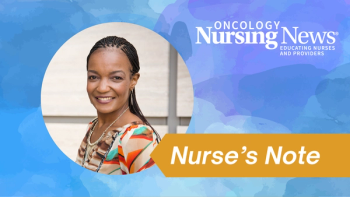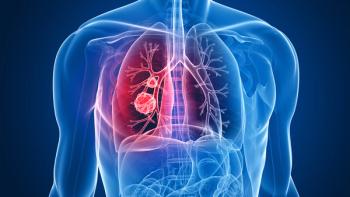
- December 2011
- Volume 5
- Issue 8
Oncology Nurse Perspectives on Developments in Cancer Care
Nurses provide their unique perspectives on many of the recent clinical trials and developments in cancer research.
NSCLC Paradigm Shift
Colleen M. O'Leary, RN, MSN, AOCNS
Otolaryngology Clinical Nurse Specialist
The James Cancer Hospital
The Ohio State University Medical Center, Columbus
Adjuvant chemotherapy is now the standard of care for early resectable NSCLC, with cisplatin/vinorelbine (CVb) being the most common doublet used. As Belani points out, this treatment is not without difficulty. Toxicities identified in the initial study included neutropenia (88%), fatigue (81%), nausea (80%), anorexia (55%), vomiting (48%), neuropathy (48%), and constipation (47%), with severe (> grade 3) toxicities occurring 40% of the time (N Engl J Med. 2005;352:2589-2597).
This is why the TREAT study looked at a different combination of agents comparing CVb to cisplatin/pemetrexed (CPx). As discussed, the outcomes of this adjuvant therapy were comparable to CVb with less toxicity, and thus fewer treatment reductions or delays.
Continued use of these and other chemotherapy regimens as maintenance therapy has switched the idea of NSCLC as a chronic disease rather than an acute disease. Nurses may be in the prime role for this paradigm switch. Not only is the nurse the first person to assess the patient and his/her toxicities, but they are crucial to educating the patient about potential problems to report. Knowing the degree of toxicity and early recognition may help to decrease the amount of delay in treatment.
The next step that Belani discussed is delving deeper into the knowledge that there are specific mutations in NSCLC that respond differently to different treatments. Patients with NSCLC with EGFR mutations have been successfully treated. The IPASS study looked at gefitinib versus conventional chemotherapy, with gefitinib demonstrating longer progression-free survival and increased response rates. Erlotinib was subsequently studied with equally good results. However, patients with specific T790M or MET gene mutations develop erlotinib resistance after time.
Find out more >>>
PARP Inhibition in TNBC
Marsha Schmit, RN, BSN
Breast Health Navigator
Hurley Medical Center
Flint, Michigan
PARP inhibitors originally instilled a great deal of optimism in helping treat women with breast cancer. While the initial hope and promise for PARP inhibitors has declined significantly, there is still belief in its use in triple-negative disease, especially with a DNA mutation of BRCA1 and BRCA2.
Since triple-negative breast cancer is more aggressive and requires more aggressive neoadjuvant intervention, the PARP inhibitors continue to show possibility. Clinical trials that continue to explore the potential benefits along with a combination of therapy are encouraging. PARP inhibitors as a monotherapy do not seem to show a significant improvement in pretreated triple-negative disease. It is, however, imperative that clinical trials continue looking more closely at various biomarkers and combination therapy.
It is too soon to abandon hope in PARP inhibitors altogether. Perhaps it is more important to look at a combination of therapies, timing, dosing and the long-term survival advantage when other interventions have not been successful.
Find out more >>>
CRC Screening Linked to Fatalism
Laura Metcalfe, MSN, RN, APN, C, AOCNS®
John Theurer Cancer Center, Hackensack, New Jersey
Cancer fatalism beliefs have been shown repeatedly to thwart screening and treatment, according to Barbara Powe, PhD, director of underserved population research at the American Cancer Society (J Natl Cancer Inst. 2007;99[16]:1222-1223). I think it is incumbent upon nurses, especially oncology nurses, to educate the public about the importance of screening. Screening can detect cancer at an earlier stage and, as we know, earlier detection leads to better outcomes and even cures. I would be remiss if I didn’t also point out that screening colonoscopies cannot only detect cancer at an early stage, but can sometimes stop cancer from developing (by removing precancerous polyps).
Of course, even better than early detection through screening is outright prevention. By exercising, eating a healthy diet, and not smoking, many cancers can be avoided. However, studies have shown that those people who have a fatalistic attitude toward cancer also believe there’s nothing they can do to prevent it. It would seem logical that this would be the place to start in educating the public. Getting people to understand the connection between an unhealthy lifestyle and the increased risk for cancer would, hopefully, lead to changes in behavior.
In recent years we’ve learned that exercise and a healthy diet (eg, fruits, vegetables, whole grains, fish) are linked to decreased heart disease, arthritis, Alzheimers, depression, and even cancer. While change is often slow, my hope is that we will see the effects of all this information related to diet over the next few years with decreased obesity and its all-too-familiar comorbidities. I think it naturally follows that if people adopt a healthier lifestyle that they will begin to feel more control over their health. A sense of control has been shown in other diseases (eg, diabetes, heart disease) to impact health behaviors.
If people understood, and believed, that a healthy diet and lifestyle could help them decrease their risk of certain cancers, it should follow that they would be more likely to undergo the appropriate cancer screenings. In summary, while an individual’s beliefs are often deeply ingrained and difficult to change, nurses need to continue to educate people in order to effect change. As pointed out in this study, screenings were low even when healthcare was free. While access to care is still of paramount importance, changing beliefs, especially fatalism towards healthcare, is even more important to ensure that people actually undergo the appropriate cancer screenings.
Find out more >>>
High-Dose Radiation for NSCLC
Pamela Ann Hall, RN, OCN®, BSN
Radiation Oncology Nurse/Patient Navigator
Welch Cancer Center
Sheridan, Wyoming
The first part of the ongoing RTOG 0617 trial asks, “Does high-dose radiation therapy (74 Gy) offer an overall survival benefit to patients with stage III NSCLC compared with standard care (60 Gy)?” One can only agree that the advantages of low-dose radiation (60 Gy) outweigh those of the high-dose (74 Gy) and should be the standard going forward. Especially since the Data Safety Monitoring Board (DSMB) stepped in and closed the 2 high-dose arms due to the futility threshold being crossed. Not to say that high-dose is specifically detrimental by itself, but the combination with chemotherapy and cetuximab might be the culprit. Once the data are released, we will know if there was a significant negative impact on patients with the use of the high-dose radiation, or if it was just not improving nor hurting patient outcomes.
From a nurse’s perspective this is an excellent chance to educate the patient in the quality-of-life components of this study. This is an opportunity for patients to report main toxicities during chemoradiation. Prior studies have reported how significant sensitive and meaningful methods are to accurately capture normal tissue toxicities from patient report outcomes (PROs) are. Since one of the multivariate analyses for worse survival was radiation dose with toxicities, this is important.
The second part of the trial asks, “Is there a survival benefit with cetuximab?” The 2 arms randomizing patients to 60 Gy with concurrent chemotherapy with or without cetuximab remain open to accrual. Although cetuximab in this trial remains experimental and not approved by the FDA for treatment of lung cancer, it is encouraging as shown by previous phase I, II, and III clinical trials involving NSCLC.
Find out more >>>
Articles in this issue
almost 14 years ago
2011 in Review: NCONN Continues to Change the Face of Cancer Carealmost 14 years ago
Chemo Controversy: An Inside Look at the 'Hot Chemotherapy Bath'about 14 years ago
Advanced Cancer Care: Is It Real Care if It Comes Too Late?Newsletter
Knowledge is power. Don’t miss the most recent breakthroughs in cancer care.































































































